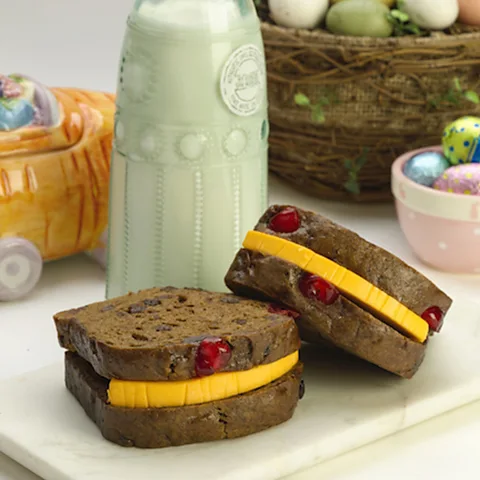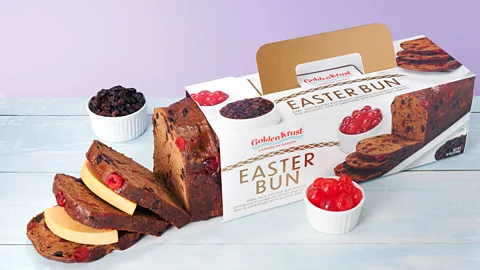During Easter, soft cheese sandwiched between two slices of moist, fruit-infused spiced bun make up a savoury-sweet Jamaican tradition.
Every year, as Easter approaches, restaurants and lunch counters in Jamaican communities around the world begin to line their glass pastry cases with glistening cinnamon-and-nutmeg-spiced buns, while Caribbean markets dot their shelves with vividly coloured tinned cheese. Though the official start of spring may be heralded by warmer weather and budding flowers, for me – growing up in a Caribbean household – the season really begins when these two things come together to form bun and cheese.
At first glance, the pairing of sweet, spiced buns – which aren't typical "buns" but loaves cut into slices – with a savoury soft yellow cheese sandwiched together may seem like a peculiar combination. However, much like the charcuterie classic of cheese and jam, or a chocolate-covered pretzel, it offers a salty-sweet allure.
Each slice of a glossy spiced bun is speckled with glazed candied cherries and dried raisins – or candied citrus peel known as "mixed peel – and sweetened by a combination of brown sugar and molasses, agave nectar or guava jam. Its brown colour is often deepened by browning sauce – a syrupy liquid seasoning made of burnt brown sugar and water, often used to add colour to stews. In many variations of spiced bun, a dark, stout beer helps it rise to its signature height.
The salty cheese sandwiched between the bun can most accurately be described as the best version of a cross between mild cheddar and American cheese. The signature processed cheese brand used for this treat today is dubbed Tastee Cheese, and it slices like cold butter.
 Golden Krust
Golden KrustThe centuries-old Jamaican tradition of bun and cheese is to Easter as syrupy-sweet ginger sorrel and boozy black cake are to the winter holidays. It's available and can be enjoyed year-round, but the holiday is when the dish shines most.
"If you grow up with it, it's hard to forget. It's a highlight in Jamaica… you can smell it – the aroma is just different, the texture is different," recalls Steven Clarke, vice president of marketing for the first Caribbean restaurant franchise in the US, Golden Krust. Clarke is also the grandson of Mavis and Ephraim Hawthorne, who founded Hawthorne & Sons Bakery in the region connecting Jamaica's south-western parishes of Westmoreland and St Elizabeth – known as "Border" in 1949. The two developed the spiced bun recipe that Golden Krust has used for more than 70 years.
"I remember seeing Papa [my grandfather] just standing beside the line touching every bun," Clarke says, a testament to the importance of bun texture, which should be dense and moist enough to squeeze and mould into a shape and hold it.
While bun and cheese is now deeply ingrained in Jamaican culture, it's likely that the treat is rooted in 17th-Century British colonisation. Hot cross buns, the closest predecessor to the Jamaican bun, were a similar baked good made with spices and dried fruit, eaten on Good Friday, and iced with a crucifix – hence the name. The cross was originally made with a simple flour-water paste, but over time, it evolved into a sweet icing made with powdered sugar and milk, adding a touch of sweetness to the bun.
The first recorded reference to hot cross buns appeared in the 17th- and 18th-Century Poor Robin's Almanac, a satirical text that read:
Good Friday comes this month, the old woman runs
With one or two a penny hot cross buns.
The rhyme reflects the tradition of selling hot cross buns on the streets on Good Friday, as it is believed that the buns were often given to the poor as a form of alms and were believed to have medicinal properties.
The tradition of a bun specifically consumed during religious ceremonies, however, predates the British tradition. In ancient Greece, small loaves of bread were offered to the goddess Demeter as a symbol of the harvest. Now, a sweet bread called tsoureki is typically baked for Easter. This braided bread is flavoured with orange zest and spices like mahlab (a spice made from cherry seeds) and mastic. Much like cherry-topped versions of spiced bun, tsoureki can be decorated with dyed red eggs, symbolising the blood of Jesus Christ.
While the hot cross bun's origins are typically associated with Easter and Good Friday, its history extends beyond Christian traditions. In ancient Assyria, the cross-marked bread was believed to be an offering to the Goddess Ishtar in Babylon. These were often decorated by markings symbolising the Moon's four quarters. Similarly, British hot cross buns were also associated with superstitions and folklore, which states that a bun baked on Good Friday would never spoil, and that keeping one in the house would protect it from fire and ensure that all bread baked in the house would turn out well. Now, Jamaican tradition has bound the treat to a looser interpretation of "protection" as a symbol of fellowship, or "breaking bread" with friends and family.
 Golden Krust
Golden KrustSpiced bun also represents a sense of Jamaican culinary pride that's been brewing for centuries. Laura Adderley, Associate Professor of African Diaspora History at Tulane University, noted the relationship between the Jamaican sense of attachment to the dish, and the sense of pride that Caribbeans take in creating something new.
"What's interesting is the way that, particularly over the past 100 years, people in the Caribbean, [and] especially in Jamaica, have been [active] about this business of making – making both a regional culture even before independence, and a national culture. There's now a sense of Jamaican ownership over [spiced bun]."
According to Clarke, bun and cheese’s evolution represents a very a fundamental characteristic of Jamaican food culture. "We applied our own flair to it, our culinary ingenuity, to make it our own," he said. As with curry originally derived from India, and jerk spice adapted from the Caribbean's Indigenous Taíno people, Jamaicans pulled spices that were abundant and popular to them and mixed them with existing flavours to create a new staple. Even the cinnamon and nutmeg that spices the spiced bun is found in a variety of Jamaican dishes.
"[We went] from honey to more of a molasses approach, which is why the colour is what it is these days," said Clarke. "And then adding in some new ingredients – like the nutmeg, the vanilla, some stout flavouring and cherries – to really make it unique. So that is really what sets us apart. It's something that Jamaicans have done historically to take something good and make it better."
And as the dish continues to evolve, it's impact is only expanding.
 Golden Krust
Golden KrustIn recent years, bun and cheese has garnered a following beyond the island country. In areas with a large Caribbean community, bun and cheese can often be found in local markets, bakeries and restaurants. In the UK, several bakeries, and even some Tesco locations carry the dish. And while the Golden Krust bun and cheese may have originated in Border, it is now sold by the loaf and slice in stores throughout the US.
According to Clarke, this level of accessibility – combined with their sale of "fruitless" bun for the pickier Easter celebrant – has inspired a community of creative bun and cheese enthusiasts. When Golden Krust sent her a pack of fruitless spiced bun, Grammy-winning singer and flutist Lizzo recorded her own spin on the dish.
"She cut up the bun, added vegan shredded cheese, closed it and put it on a griddle. Like a grilled cheese!" said Clarke.
Others have taken the liberty of developing their own variations, from combinations as tame as bun and milk, to as singular as inserting a beef patty between two slices of spiced bun in place of cheese – a bun beef patty sandwich.
"People do actually eat bun and patty. I've seen it. It's a thing," he said.
Today, bun and cheese may be inspiring creative variations and even celebrity endorsements, but this symbol of Jamaican ingenuity and pride remains a beloved holiday tradition that ushers in the warmth and comfort of the spring season.
BBC.com's World's Table "smashes the kitchen ceiling" by changing the way the world thinks about food, through the past, present and future.


